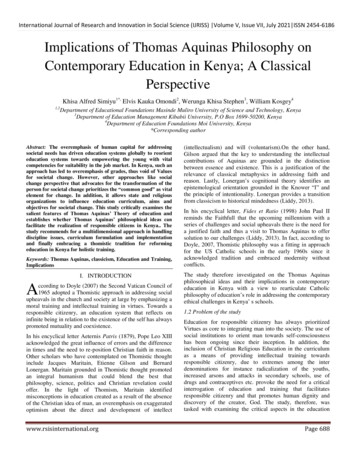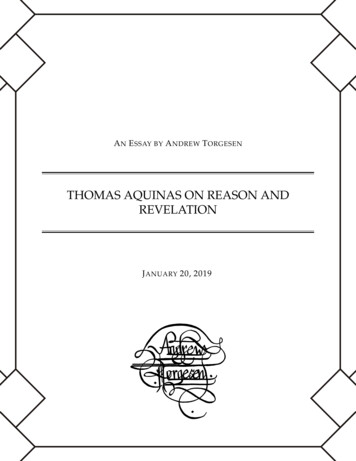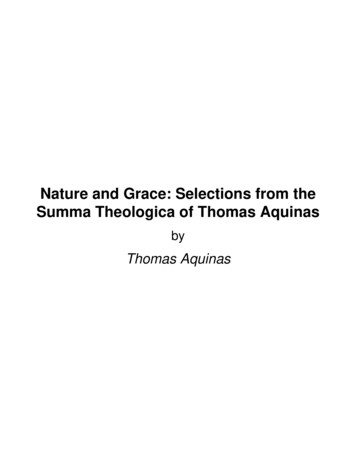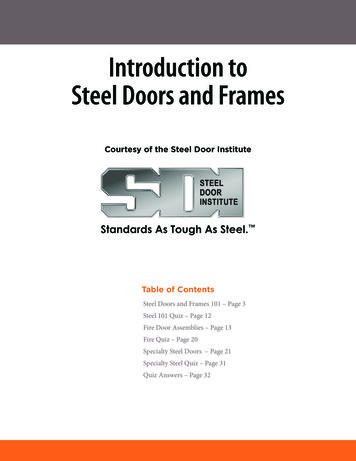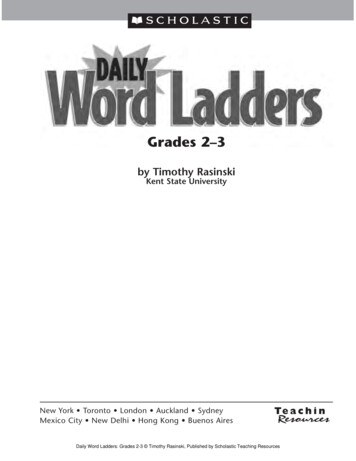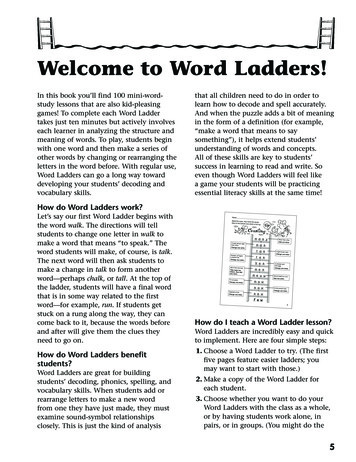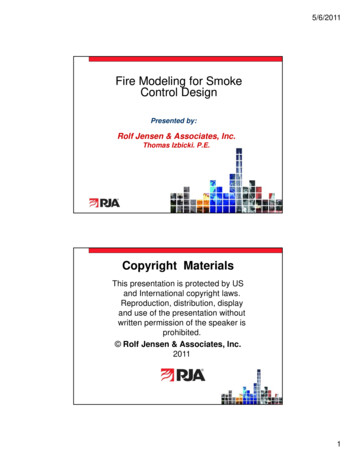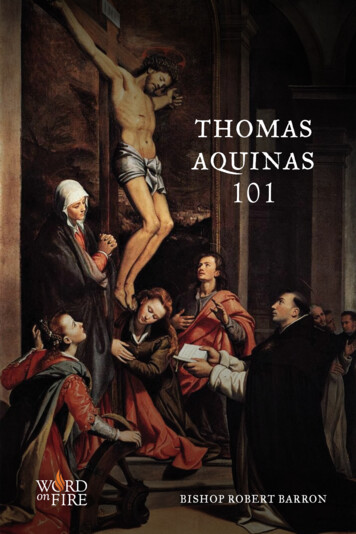
Transcription
THOMASAQUINAS101BISHOP ROBERT BARRON
THOMAS AQUINAS101by Bishop Robert BarronMy whole life changed when I discovered St. ThomasAquinas at age 15. A Dominican friar introduced him inhigh school during a lecture on the arguments for God’sexistence. That encounter helped me fall in love with thethings of God and ultimately led me to the priesthood.St. Thomas Aquinas’s influence on the Church andWestern culture has been so massive that it’s difficulteven to get a grip on it. When I discovered him I was overwhelmed by his teachings, which I barely understood. ButI remember being drawn into the complexity and wonderof his work.I want you and others to share the same experience. That’swhy Brandon Vogt and I recently devoted an episode ofour podcast, “The Word on Fire Show,” to St. ThomasAquinas, introducing his life and the best ways to startreading his work. Below you’ll find an edited transcript ofthe episode.My hope is that by reading Thomas, you come to knowthe genius and spiritual lessons of this marvelous saint.Enjoy!Peace,
THOMAS AQUINAS101Bishop Robert Barron
Word on Fire Catholic Ministries, Skokie 60077 2016 by Word on Fire Catholic Ministrieswww.wordonfire.org
QUESTION: In a few months, you’ll be releas-ing CATHOLICISM: The Pivotal Players, which isyour big follow-up to the CATHOLICISM series.Thomas Aquinas is one of the featured figures inthe new series. There’s a whole hour-long episodedevoted to his life, but perhaps here you can giveus just a brief sketch of who Thomas Aquinaswas.BISHOP BARRON: Thomas was a 13th-cen-tury Dominican friar who emerged as the greatestof the Scholastic philosophers and theologians.To understand Thomas, go back to this kind ofgolden age of Catholic culture and thought. Hewas the champion of this golden age when theChurch was in a very vibrant dialogue with theculture, to use our language today. Thomas wasaccessing the complexity of the great Catholictradition but also, in at least some of his majorworks, the ideas of Aristotle, the Greek philosopher, which were coming into vogue in the Westfor the first time.THOMAS AQUINAS 1011
Thomas was affecting this extremely creative andfecund union of biblical Catholicism with Aristotelianism, and it had (and still has) a revolutionaryimpact on the way the Church understands bothits doctrine and its relation to the culture. I thinkthe timeless influence his writing has on issuesconcerning doctrine and the culture is why heremains of such central significance today.QUESTION: Many Catholics have probablyheard the name of Thomas Aquinas and manyhave probably even heard of his major work, theSumma Theologiae, but that book can be a littleintimidating to dive into. So let’s first exploresome of his other writings. We’ll come back to theSumma in a moment, but give us a brief overviewof some of his other major works.BISHOP BARRON: Thomas wrote a num-ber of summae (we would call them “summaries”)of theology when he was a young man—we’d saylike a doctoral candidate. He wrote about thesame thing everyone in the middle ages up untilLuther’s time would have written about, namely,2THOMAS AQUINAS 101
the Book of Sentences by Peter Lombard. Theseyoung academics cut their teeth on Lombard’sSentences. Lombard’s book was really a collectionof commentaries on the Church fathers done bya famous Bishop of Paris, and they became thestandard text for young medieval theologians tostudy and reflect upon. So the young Thomaswrote a very lengthy and elaborate commentaryon the Sentences, and it kind of became his firstsumma, or summary of theology.His second summa was called the Summa Contra(Summary Against the Gentiles). Some speculate itwas written for Christian missionaries in Muslimlands. It was a highly philosophical summary ofChristianity.Then the final great summa, his Summa Theologiae, is Thomas sort of summing up his life’s work.However, he also wrote a number of biblicalcommentaries, many of which have not beentranslated into English. He also wrote a wholeslew of commentaries on Aristotle’s writings.THOMAS AQUINAS 1013
We also have a compilation of his work called,Disputed Questions. These are literary accountsof what were very lively events where a medievalmaster, like Thomas, would entertain objectionsand questions about a major theme in theology.These were later written up as literary artifactsand given the title, Disputed Questions.He also wrote things that are called the QuodlibetalQuestions. “Quodlibetal” in Latin means “whatever you want” and so the quodlibetal were eventswhere a medieval Master would come into theroom and entertain “whatever you want”—anykind of question from the floor. By all accountsThomas was the master of the quodlibetal questions, so you can find that too as part of his work.They’re all complex works; it’s not easy reading.Thomas never wrote a book called “Thomas forBeginners”. Almost everything he wrote is at afairly high level of sophistication, but there are anumber of commentators who, over the years intothe present day, offer an easier way in.4THOMAS AQUINAS 101
QUESTION: Who would some of those commentators be?BISHOP BARRON: Well, think of Peter Kre-eft. He writes a great book called The Summa ofThe Summa, which I think is a very helpful way toget sort of an overview. Think of the great F.C.Copleston, one of the really significant historiansof philosophy in the twentieth century. Readhis great sweeping A History of Philosophy, whichhas a large section on Thomas, but also a separate book of his, which is simply called Aquinas.I’d read anything by Etienne Gilson, the greatFrench Thomist scholar. And then of course thegreat G.K. Chesterton writes a book on ThomasAquinas that Gilson, by the way, said, “I considerit as being without possible comparison the bestbook ever written on St. Thomas. Nothing shortof genius can account for such an achievement [T]he few readers who have spent twenty or thirtyyears in studying St. Thomas Aquinas, and who,perhaps, have themselves published two or threevolumes on the subject, cannot fail to perceiveTHOMAS AQUINAS 1015
that the so-called ‘wit’ of Chesterton has put theirscholarship to shame.” So these authors provide anumber of ways to get into his life, his spirit, andan overview of his thought.QUESTION: I love the story that’s told ofChesterton writing his book on Aquinas. Theysay he just asked his secretary to run off to thelibrary and grab some books on Aquinas and shebrought close to a dozen. And he kind of justflipped through them, scanning here and there,and closed all the books and simply dictated hisbook on Thomas Aquinas, which the brilliantGilson, as you say, says is the best book ever written on Aquinas.BISHOP BARRON: Yeah it’s quasi-miracu-lous how Chesterton just knew how to cut to theheart of the matter, and that’s obviously part ofhis genius. He was not a technical scholar by anymeans, not a philosopher by training. He was ajournalist, an artist, really, by training—a literaryfigure. Yet he was able to see some really centralthemes in Aquinas.6THOMAS AQUINAS 101
One that I always go back to is Chesterton’sinsight that Aquinas should be called “Thomasof the Creator.” There’s something really rightabout that, about how creation is a dominantmotif in all of Thomas. That’s why some yearsago, when I was a doctoral student in Paris contemplating my doctoral thesis, I decided to writeon Aquinas and precisely on the issue of creation.I think in my mind, or in the back of my mindanyway, was Chesterton. He’s a way to get intothe whole of Thomas Aquinas.QUESTION: Lets talk about Thomas’s style.You mentioned the Disputed Questions, or inLatin the disputatio. This is the structure of Summa, where he puts forth the best objections to aparticular question and then offers his response.One of the things I’ve always admired about hiswork is that he doesn’t just put forth straw men.He puts forth the best objections and sometimeseven ratchets them up. He makes the objectionseven harder to answer, and then he responds tothem brilliantly. Talk about why that’s such agreat approach for apologetics or evangelization.THOMAS AQUINAS 1017
BISHOP BARRON: That’s quite right, andgo back again to the actual events called theDisputed Questions. Remember, these were notjust writings, they were public events. A masterteacher like Thomas, a magister as he was called—our words “maestro” and “master” come fromthat—would announce a dispute, a question.Let’s say for instance it was going to be on theIncarnation, the Trinity, or the origin of God.People would then come in great in numbers tolisten to this dispute. The master would presidebut usually they would call a baccalaureus—whatme might call a doctoral student—to actually runthe conversation. The baccalaureus would thenentertain all kinds of objections from the floor.For example someone might say, “God can’t beTrinity, because you claim God is one.” Andsomeone else would raise another objection andsay, “Yeah, but Aristotle says this ” Or anotherperson might add, “It says in the Old Testament ”or, “The Book of Job says ” So the baccalaureuswould take in all of these objections respond8THOMAS AQUINAS 101
as best he could, but all the time the magister,Thomas, would be taking it all in quietly.Then he would go back and think it through onhis own and come up with what they call therespondio, which in Latin just means “I respond.”Essentially, he puts forth his resolution of the matter, and typically he would take what he thoughtwere the five or six best objections and then he’danswer those. So when you’d return the next dayfor round two of the Disputed Questions, that’swhat you’d hear, you’d hear the respondio, whichis the magister’s answer to the initial question andhis response to the best objections.When you read Aquinas’ Summa, it may seemlike a really dry text, but I encourage you to seebehind that text to this very lively public disputewhere you’ve got this brilliant magister who is notonly resolving a question but answering five really good objections. And that’s why you rightlysay that they aren’t straw men at all. Maybe therewere, in fact, a lot of silly comments made or somestupid objections, but the five or six really goodTHOMAS AQUINAS 1019
ones Thomas would remember, and that’s whatwe find in the Summa.So as you suggest, it’s a really good model forapologetics, because it’s respectful to the opponent by not just running roughshod over anyobjection. Rather, it’s taking very seriously people’s objections and treating them in a respectfulway. I think it’s a good model for anyone doingapologetics today.QUESTION: How do you think Thomas wouldengage, if he would, the so-called New Atheists today? If Thomas Aquinas had a YouTube accountdo you think he’d jump in the comment boxes?BISHOP BARRON: Yeah, I do. I think thatthe Internet forums today are not all that dissimilar from a disputed question in the Middle Ages.We’re hearing from the floor, which now meansanyone who can jump on YouTube. So that’s notdissimilar to the medieval disputatio.In my own way I’m responding to the objections10THOMAS AQUINAS 101
online. Let’s say the articles I write or a YouTubevideo might be like a respondio, a more encompassing answer and response to the objections that I’veheard. I like it, and I think there’s something veryCatholic about it. The very lively conversation,the exchange of ideas, the willingness to dialoguewith the culture—you can trace all of that backto the Platonic dialogues. This concept is something which has been alive in the West for a longtime, the idea that the best way to get to the truthis through a sort of structured conversation, andthat was imminently true in the Middle Ages.Keep something in mind: what we know todayas the university lecture is something that camereally out of Friedrich Schleiermacher’s University of Berlin in the mid-19th century. The ideaof the master coming out and giving a lengthylecture while the students take notes in their seatsis a relatively recent form. Go back to the Oxfordstyle, which still perdures today. In fact, C.S.Lewis practiced it. It’s not a lecture so much butrather a lively dialogue with your tutor. You reada book together and then Q&A and then maybeTHOMAS AQUINAS 10111
you’d write a paper, which maybe he’d respond toand critique.Now go back to the Middle Ages, you didn’thave so much lecture as you had these questionesdisputate. Go back all the way to the beginning,to Plato or to Aristotle and the peripatetic school,wherein the teacher walked around dialoguingwith his students. Those are much older and moreclassical forms of knowing and learning, and theyare very much on display in Aquinas.QUESTION: Before we get into how to readthe Summa, let me ask a simple question: why is itworth reading Thomas Aquinas?BISHOP BARRON: Because he’s one of themost brilliant people that’s ever emerged in theWest. I’d rank him with Plato, Aristotle, Kant, Hegel, and Wittgenstein. He is probably one of thefive or six most brilliant people that the West hasever produced. Simply put, if you’re interested inphilosophy at the highest level, you read Thomas.12THOMAS AQUINAS 101
Secondly as a theologian he’s called the “DoctorCommunis” or the Common Doctor. There’ssomething about Thomas that’s just a touchstonefor all of Catholic theologizing. He summed upall that came before him and set a template thathas been largely followed ever since. Of course,he’s not the only theologian that you ever read,but Aquinas has a touchstone quality to his work.I find that he reminds me of people like Chesterton or Lewis in that just you keep finding so manytrue things in his writings. As you read other bookson a particular question, you think, “Yeah, yeah,that’s ok.” And other times you think, “No, that’snot right,” or, “Yeah, that’s got something to it.”But then you read Thomas and you exclaim, “Yes,yes that’s it! That’s the best way to resolve thisthing.” I’ve had that experience a lot with him.I had it when I was 15 years old, and I’ve studiedhim all my life. So I’d say read Thomas becausehe’s right about an awful lot of things.QUESTION: So that’s why to read ThomasAquinas, let’s get into the how question. A lotTHOMAS AQUINAS 10113
of people who first discover the Bible for the firsttime attempt to read it beginning with the firstpage of Genesis, straight through to Revelation,but they usually get lost somewhere around Leviticus. Would you recommend somebody breakinginto the Summa in the same way, beginning withthe first question, or is there a better path to reading it?BISHOP BARRON: We mentioned the co-mentaries, and I think that’s a wise course. Readsome commentaries. Get Copleston’s little book,which can be read in a few sittings, for the overview. Read Chesterton for more kind of lyrical,poetic introduction. Then get Kreeft’s Summa ofthe Summa, which would take you through it in amore organized way.Also I’d say this about Thomas, there’s kind of anencyclopedic quality to him. So you don’t reallypick up the encyclopedia and just start readingit. What you do is you say, “I’m interested inthis issue so let me look that up in the Summa.”There might be a particular issue in theology that14THOMAS AQUINAS 101
interests you, and when it does, go to that sectionof the Summa and find that question.Here’s something else I recommend that I heardmany years ago from a wise Thomist: if you wantto plow through the Summa and not lose theforest for the trees, don’t read the objections andthe answers—just read the respondios. Now a lotis happening in the objections and the responses, don’t get me wrong. Often the coolest, mostinteresting stuff is there, but to get a sense of thewhole thing and the rhythm of it, just read therespondios as you go through.Another route to start the Summa is to read thefirst thirteen questions, which have to do withGod and God’s attributes. Why is there a God?Why is God one? Why is God immaterial? Whyis God eternal? That would be good way to getinto Aquinas.Or if you’re into Christology, skip to the third partof the Summa. Read the first 12 or so questions ofthe third part and you get all this technical discussion about the person of Jesus Christ.THOMAS AQUINAS 10115
QUESTION: Give us a sense of the landscapeof Summa. There are multiple parts. It’s very orderly, isn’t it?BISHOP BARRON: Keep in mind that themedieval people, who were immersed in Trinitarian theology, often thought in terms of threes.Dante’s a good example: look at the three majorsections of the Divine Comedy. Each one is dividedinto thirty-three cantos, and each canto is dividedinto little stanzas of terza rima where the thirdline rhymes. You keep seeing three, three, three.Also look at a gothic cathedral where there arethree elevations and usually three aisles. Threeis a big number in the medieval world, and so itis in Thomas. The Summa Theologiae has threemajor parts. The first one, Prima Pars, has to dowith God and creation. The Secunda Pars (secondpart) is divided into two: what they call the PrimaSecundae, which means the first of the second, andthe Secunda Secundae, which means the second ofthe second. So Secunda Pars deals with the humanbeing and human acts and the journey back toGod. If the Prima Pars deals with God and what16THOMAS AQUINAS 101
comes out from God (i.e., Creation), the SecundaPars concerns the journey back to God throughvirtue and the good life.Finally, the Tertia Pars (third part) has to do withthe Way in the full sense of the term, namely, Jesus,who said, “I’m the Way, the Truth, and the Life.”So the Tertia Pars is all about Jesus—his life, deathand resurrection—and the sacraments that nowbring his life to bear on us.Thomas never finished the third part. He diedright after he finished the section on penance.He got through Jesus’ story and four of the sacraments, and then he died. But that’s the mostgeneral overview: first part is God and creation,second part is humanity and the human act, thirdpart is Jesus and sacraments.QUESTION: Let me ask one final question.Thomas is sometimes depicted as this super-rational, egghead philosopher/theologian, butwhen you wrote your book on Thomas Aquinasyou subtitled it, Spiritual Master. Is this attributeTHOMAS AQUINAS 10117
sometimes overlooked? Do people tend to forgetthat Thomas was not just a brilliant mind, but aspiritual master as well?BISHOP BARRON: Yes, absolutely. You kn-ow it’s a complicated thing, because Thomas wastrying to write theology in a very rational, Aristotelian scientific way. When they used the word“science” they were thinking of the Aristotelianscience of the Four Causes. Thomas was trying towrite in this hyper-disciplined way, so it’s not likethe church fathers. Thomas’s writing was significantly difference. Compare Thomas to any of theChurch fathers including Augustine, and you’llsee how Thomas is different. Thomas offers hisown style, this hyper-rationalized very Scholasticacademic approach. I wouldn’t want to gainsayany of that. However, you can miss the heart ofThomas if you look simply at the hyper-rationalmethod.First and foremost Thomas was a Dominican friar, which means he was a preacher. Well, if you’rea preacher, you have to be a Bible commentator,18THOMAS AQUINAS 101
because the Holy Bible is the soul of preaching.And Thomas indeed did a lot of Bible commentary. If you’re a Bible commentator, you’re goingto face anomalies. You will have to come to termswith questions and puzzles like, “How do I interpret this scripture against that scripture?” Whathappens then is “disputed questions” arise, right?If you bring all your disputed questions togetherinto one great summary statement, you get aSumma. My point here is for us to understandthe downward correlation between the Summa,the Disputed Questions, Bible commentary, andpreaching—ultimately the whole enterprise is inservice of preaching! And what’s preaching allabout? Transformation, which is what we todaycall “spirituality”.If you had asked Thomas to distinguish hisspirituality from his theology, he wouldn’t haveunderstood the request. Those terms would nothave made sense to him. His theology is his spirituality. I would say that his theology informs hiswork both as a preacher and someone who shapespreachers.THOMAS AQUINAS 10119
Remember now, he’s the founder of whatthey called studiums. A studium was a Dominican house—today we call them a “house ofstudies.” What happened at a studium? Well,young Dominicans were formed in order tobe preachers. That is a key to understandingThomas: his life’s work centered on the sacredpractice of preaching, with the ultimate goalof leading people to spiritual transformation.20THOMAS AQUINAS 101
For more conversations like this one, be sure to check out“The Word on Fire Show” at WordOnFireShow.com.You’ll also find instructions on how to subscribe to newepisodes so you’ll never miss one.THOMAS AQUINAS 10121
why Brandon Vogt and I recently devoted an episode of our podcast, “The Word on Fire Show,” to St. Thomas Aquinas, introducing his life and the best ways to start reading his work. Below you’ll find an edited transcript of the episode. My hope is that by reading Thomas, you come to kn
